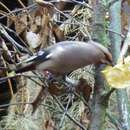en
names in breadcrumbs


Adult Bohemian waxwings are medium sized (33.02 cm wingspan and 16-19 cm body length) and have a general flycatcher shape. Their heads have a reddish-brown tinge with a crest on the top and their eyes and chin area are covered by a black “mask”, although juveniles lack this mask (All About Birds 2017; Seattle Audubon 2017). Adults are a brownish gray, while juveniles are primarily gray, with brown mottling on their underparts. B. garrulus has yellow patches on the tips of its wings, along with white and black edging. Juveniles lack these feather tips. As the birds mature, the size and amount of colored feather tips seem to increase. Their tails have yellow markings and are tinged red underneath (Seattle Audubon 2017; All About Birds 2017).
The Bohemian waxwing is closely related to and is often mistaken for the Cedar waxwing (Bombycilla cedrorum). The Bohemian waxwing can be distinguished from the Cedar waxwing by its larger size, its yellow and white feather tip markings, and its call (Seattle Audubon 2016). The call of B. garrulous is a high pitched, lisping “see”, and is harsher and more grating than the call of the Cedar waxwing (Kaufmann 2017).
In spring, , B. garrulus populations make migratory movements from southern wintering ranges in the northwestern U.S. and southwest Canada to breeding sites in Alaska and northwest Canada. Breeding locations may change annually, most likely in response to fruit availability. There are nonbreeding populations from the southern border of Canada into the U.S., extending further south in the west and receding northward toward the east coast. There is a year-round population where the nonbreeding and breeding ranges overlap in southwest Canada. Breeding takes place in mid-June, which is late in comparison to most birds. In September, they depart their breeding areas and arrive in south central British Columbia through October, in Oregon by mid-November, and large flocks sometimes reach northern California in January and February (Witmer 2002).
B. garrulus lives in open areas in the forest near the edges of burns, and in places with dispersed tall trees above their bushy understory. During the winters, they spend their time in semi-open wooded areas where food is more available. They tend to stay near towns where there are many planted fruits and berries. Some of the wild berries they eat in abundance are those of mountain-ash and junipers (Kaufmann 2017). Along with berries, Bohemian waxwings also eat insects, particularly flying ones. Breeding and migration depend on availability of crops, since their diet for the winter is dependent on vegetation as opposed to insects (Witmer 2002).
These birds are monogamous and are non-territorial. Because of their non-defensive nature, Bohemian waxwings lack a true song. They form large migratory flocks in which individual birds fly very close together with little to no aggression. They practice courtship which includes gift-giving, feeding, and billing (Witmer 2002). During the display of gift-giving, both birds perch close together with body feathers puffed out and the male passes a berry, flower, or other small item to the female. Their nests are typically built on the horizontal branches of spruce trees anywhere from 1.8 - 6.1 meters above the ground. Both sexes participate in the building of the nest which is composed of twigs, grass and moss lined with softer materials like feathers and fine grass. Females typically lay 4-6 pale bluish-gray eggs that are heavily dotted with black towards the wider end. Both parents feed the nestlings. The young flee the nest anywhere from 14-18 days after hatching and continue to associate with parents through the first fall and winter migration (Kaufmann 2017).